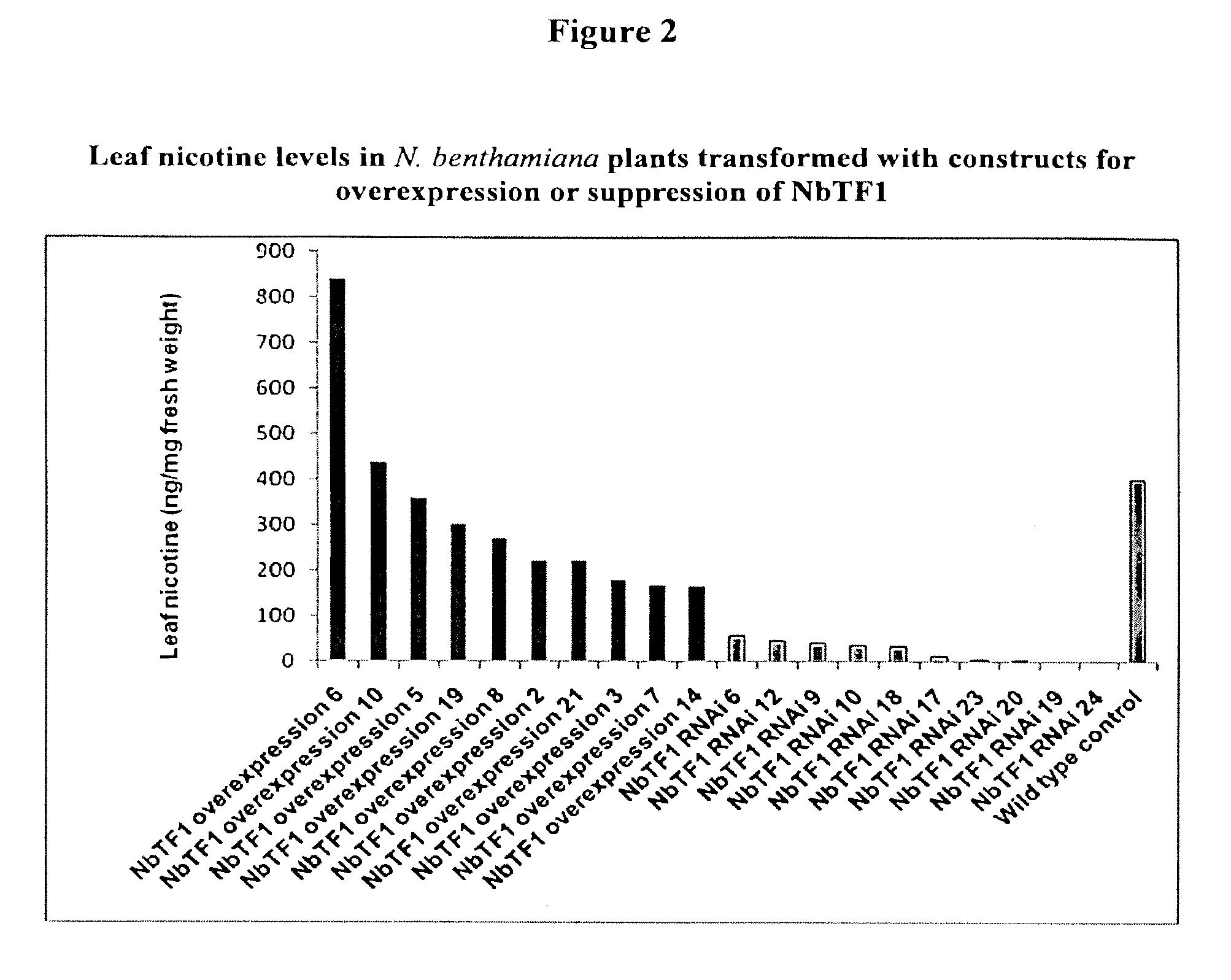Nucleic acid sequences encoding transcription factors regulating alkaloid biosynthesis and their use in modifying plant metabolism
a technology of transcription factors and nucleic acids, which is applied in the field of transcription factors regulating alkaloid biosynthesis and their use in modifying plant metabolism, can solve the problems that the actual regulatory machinery responsible for induction has yet to be discovered, and achieve the effects of reducing the levels of transcription factors in the plant, reducing alkaloid plants, and reducing alkaloid plants
- Summary
- Abstract
- Description
- Claims
- Application Information
AI Technical Summary
Benefits of technology
Problems solved by technology
Method used
Image
Examples
example 1
Construction of Subtractive cDNA Libraries from Nicotiana benthamiana Roots, EST Sequencing and Selection of Transcription Factor Genes
[0122]Nicotine biosynthesis occurs in the roots of Nicotiana species (Dawson, Science 94: 396-397 (1941)) and is induced by insect damage, wounding and the application of jasmonates (Winz and Baldwin, Plant Physiol. 125: 2189-2202 (2001)). In order to identify genes encoding transcription factors that control nicotine biosynthesis, we combined expressed sequence tag (EST) sequencing of methyljasmonate (MeJa)-induced roots of Nicotiana benthamiana with functional analysis using virus-induced gene silencing (VIGS) (Liu and Page, Plant Methods 4: 5 (2008)).
Hydroponic Cultivation of Nicotiana benthamiana
[0123]Nicotiana benthamiana Domin (Solanaceae) seedlings were grown hydroponically in 0.25× Hoagland's solution supplemented with iron chelate solution and oxygenated using an aquarium bubbler. Roots from three-week old plants were sampled before (t=0) a...
example 2
Cloning of Full-Length cDNAs for Transcription Factors Affecting Leaf Nicotine Accumulation
[0137]I.A.1.5 Full-length cDNAs were obtained using rapid amplification of cDNA ends (RACE) PCR.[0138]I.A.1.6 NbTF1[0139]I.A.1.7 5′ and 3′ RACE PCR was used to obtain the full-length cDNA sequence of NbTF1. The full-length NbTF1 transcript was 2313 bp in length encoding an open reading frame (ORF) of 2040 bp. The sequence of the NbTF1 gene from N. benthamiana is set forth in SEQ ID NO: 1. The sequence of the NbTF1 open reading frame (ORF) is set forth in SEQ ID NO: 2. The predicted amino acid sequence of N. benthamiana NbTF1 is set forth in SEQ ID NO: 3.[0140]I.A.1.8 NbTF3[0141]I.A.1.9 The NbTF3 sequence identified from the EST sequencing was a 295 bp singleton that was extended via genome walking (Genome Walker kit, Clontech), to yield a 626 bp fragment. Despite the use of 5′ and 3′ RACE PCR and further application of genome walking, we did not obtain additional sequence information for NbTF3...
example 3
Modifying Alkaloid Biosynthesis in Transgenic Plants
[0151]We used stable transformation of N. benthamiana to introduce the six transcription factor genes as both sense overexpression constructs (for NbTF1, NbTF4, NbTF5, NbTF6, NbTF7) and RNA interference (RNAi) constructs (for all six transcription factors). Open reading frames (for overexpression) and cDNA fragments (for RNAi) were amplified using PCR and cloned into the Gateway® entry vector pCR8 / GW / TOPO (Invitrogen) or pENTR-D / TOPO (Invitrogen). Overexpression constructs were recombined into the Gateway® plant transformation vector pK7WG2 using LR clonase (Invitrogen). Similarly, RNAi constructs were recombined into the Gateway® RNAi vector pK7GW1WG2(I). All cloning procedures were performed in E. coli and final, sequence confirmed constructs were transformed into Agrobacterium tumefaciens C58. Plants were transformed using leaf disc methods adapted from Draper et al. (In: Plant Genetic Transformation and Gene Expression: A Labor...
PUM
| Property | Measurement | Unit |
|---|---|---|
| temperature | aaaaa | aaaaa |
| temperature | aaaaa | aaaaa |
| flow rate | aaaaa | aaaaa |
Abstract
Description
Claims
Application Information
 Login to View More
Login to View More - R&D Engineer
- R&D Manager
- IP Professional
- Industry Leading Data Capabilities
- Powerful AI technology
- Patent DNA Extraction
Browse by: Latest US Patents, China's latest patents, Technical Efficacy Thesaurus, Application Domain, Technology Topic, Popular Technical Reports.
© 2024 PatSnap. All rights reserved.Legal|Privacy policy|Modern Slavery Act Transparency Statement|Sitemap|About US| Contact US: help@patsnap.com










